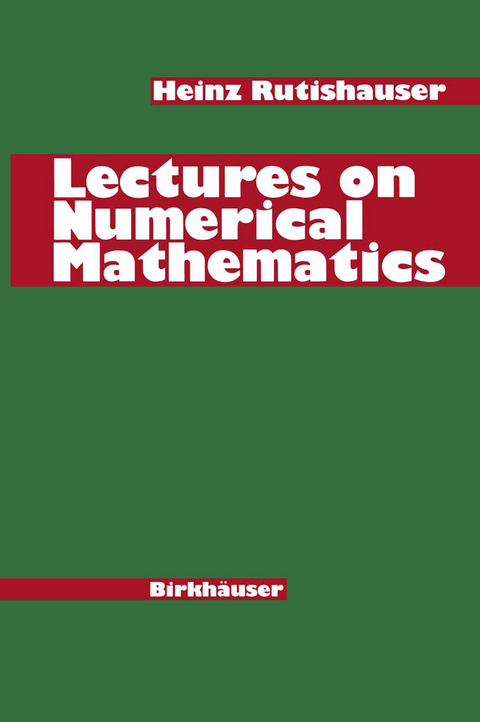
Lectures on Numerical Mathematics
Springer-Verlag New York Inc.
978-1-4612-8035-4 (ISBN)
1. An Outline of the Problems.- § 1.1. Reliability of programs.- § 1.2. The evolution of a program.- § 1.3. Difficulties.- Notes to Chapter 1.- 2. Linear Equations and Inequalities.- § 2.1. The classical algorithm of Gauss.- § 2.2. The triangular decomposition.- § 2.3. Iterative refinement.- § 2.4. Pivoting strategies.- § 2.5. Questions of programming.- § 2.6. The exchange algorithm.- § 2.7. Questions of programming.- § 2.8. Linear inequalities (optimization).- Notes to Chapter 2.- 3. Systems of Equations With Positive Definite Symmetric Coefficient Matrix.- § 3.1. Positive definite matrices.- § 3.2. Criteria for positive definiteness.- § 3.3. The Cholesky decomposition.- § 3.4. Programming the Cholesky decomposition.- § 3.5. Solution of a linear system.- § 3.6. Influence of rounding errors.- § 3.7. Linear systems of equations as a minimum problem.- Notes to Chapter 3.- 4. Nonlinear Equations.- § 4.1. The basic idea of linearization.- § 4.2. Newton’s method.- § 4.3. The regula falsi.- § 4.4. Algebraic equations.- § 4.5. Root squaring (Dandelin-Graeffe).- § 4.6. Application of Newton’s method to algebraic equations.- Notes to Chapter 4.- 5. Least Squares Problems.- § 5.1. Nonlinear least squares problems.- § 5.2. Linear least squares problems and their classical solution.- § 5.3. Unconstrained least squares approximation through orthogonalization.- § 5.4. Computational implementation of the orthogonalization.- § 5.5. Constrained least squares approximation through orthogonalization.- Notes to Chapter 5.- 6. Interpolation.- § 6.1. The interpolation polynomial.- § 6.2. The barycentric formula.- § 6.3. Divided differences.- § 6.4. Newton’s interpolation formula.- § 6.5. Specialization to equidistant xi.- § 6.6. The problematic natureof Newton interpolation.- § 6.7. Hermite interpolation.- § 6.8. Spline interpolation.- § 6.9. Smoothing.- § 6.10.Approximate quadrature.- Notes to Chapter 6.- 7. Approximation.- § 7.1. Critique of polynomial representation.- § 7.2. Definition and basic properties of Chebyshev polynomials.- § 7.3. Expansion in T-polynomials.- § 7.4. Numerical computation of the T-coefficients.- § 7.5. The use of T-expansions.- § 7.6. Best approximation in the sense of Chebyshev (T-approximation).- § 7.7. The Remez algorithm.- Notes to Chapter 7.- 8. Initial Value Problems for Ordinary Differential Equations.- §8.1. Statement of the problem.- § 8.2. The method of Euler.- § 8.3. The order of a method.- § 8.4. Methods of Runge-Kutta type.- § 8.5. Error considerations for the Runge-Kutta method when applied to linear systems of differential equations.- § 8.6. The trapezoidal rule.- § 8.7. General difference formulae.- § 8.8. The stability problem.- § 8.9. Special cases.- Notes to Chapter 8.- 9. Boundary Value Problems For Ordinary Differential Equations.- § 9.1. The shooting method.- § 9.2. Linear boundary value problems.- § 9.3. The Floquet solutions of a periodic differential equation.- § 9.4. Treatment of boundary value problems with difference methods.- § 9.5. The energy method for discretizing continuous problems.- Notes to Chapter 9.- 10. Elliptic Partial Differential Equations, Relaxation Methods.- §10.1. Discretization of the Dirichlet problem.- §10.2. The operator principle.- §10.3. The general principle of relaxation.- §10.4. The method of Gauss-Seidel, overtaxation.- §10.5. The method of conjugate gradients.- §10.6. Application to a more complicated problem.- §10.7. Remarks on norms and the condition of a matrix.- Notes to Chapter 10.- 11.Parabolic and Hyperbolic Partial Differential Equations.- §11.1. One-dimensional heat conduction problems.- §11.2. Stability of the numerical solution.- §11.3. The one-dimensional wave equation.- §11.4. Remarks on two-dimensional heat conduction problems.- Notes to Chapter 11.- 12. The Eigenvalue Problem For Symmetric Matrices.- §12.1. Introduction.- §12.2. Extremal properties of eigenvalues.- §12.3. The classical Jacobi method.- §12.4. Programming considerations.- §12.5. The cyclic Jacobi method.- §12.6. The LR transformation.- §12.7. The LR transformation with shifts.- §12.8. The Householder transformation.- §12.9. Determination of the eigenvalues of a tridiagonal matrix.- Notes to Chapter 12.- 13. The Eigenvalue Problem For Arbitrary Matrices.- §13.1. Susceptibility to errors.- §13.2. Simple vector iteration.- Notes to Chapter 13.- Appendix. An Axiomatic Theory of Numerical Computation with an Application to the Quotient-Difference Algorithm.- Editor’s Foreword.- Al. Introduction.- §A1.1. The eigenvalues of a qd-row.- §A1.2. The progressive form of the qd-algorithm.- §A1.3. The generating function of a qd-row.- §A1.4. Positive qd-rows.- §A1.5. Speed of convergence of the qd-algorithm.- §A1.6. The qd-algorithm with shifts.- §A1.7. Deflation after the determination of an eigenvaluec.- A2. Choice of Shifts.- §A2.1. Effect of the shift v on Z’.- §A2.2. Seropositive qd-rows.- § A2.4. A formal algorithm for the determination of eigenvalues.- A3. Finite Arithmetic.- §A3.1. The basic sets.- §A3.2. Properties of the arithmetic.- §A3.3. Monotonicity of the arithmetic.- §A3.4. Precision of the arithmetic.- §A3.5. Underflow and overflow control.- A4. Influence of Rounding Errors.- §A4.1. Persistent properties of the qd-algorithm.- §A4.2.Coincidence.- §A4.3. The differential form of the progressive qd-algorithm.- §A4.4. The influence of rounding errors on convergence.- A5. Stationary Form of the qd-Algorithm.- §A5.1. Development of the algorithm.- §A5.2. The differential form of the stationary qd-algorithm.- §A5.3. Properties of the stationary qd-algorithm.- §A5.4. Safe qd-steps.- Bibliography to the Appendix.- Author Index.
| Erscheint lt. Verlag | 17.9.2011 |
|---|---|
| Zusatzinfo | XVI, 546 p. |
| Verlagsort | New York |
| Sprache | englisch |
| Maße | 152 x 229 mm |
| Themenwelt | Mathematik / Informatik ► Mathematik ► Analysis |
| Mathematik / Informatik ► Mathematik ► Arithmetik / Zahlentheorie | |
| Mathematik / Informatik ► Mathematik ► Wahrscheinlichkeit / Kombinatorik | |
| ISBN-10 | 1-4612-8035-4 / 1461280354 |
| ISBN-13 | 978-1-4612-8035-4 / 9781461280354 |
| Zustand | Neuware |
| Informationen gemäß Produktsicherheitsverordnung (GPSR) | |
| Haben Sie eine Frage zum Produkt? |
aus dem Bereich


